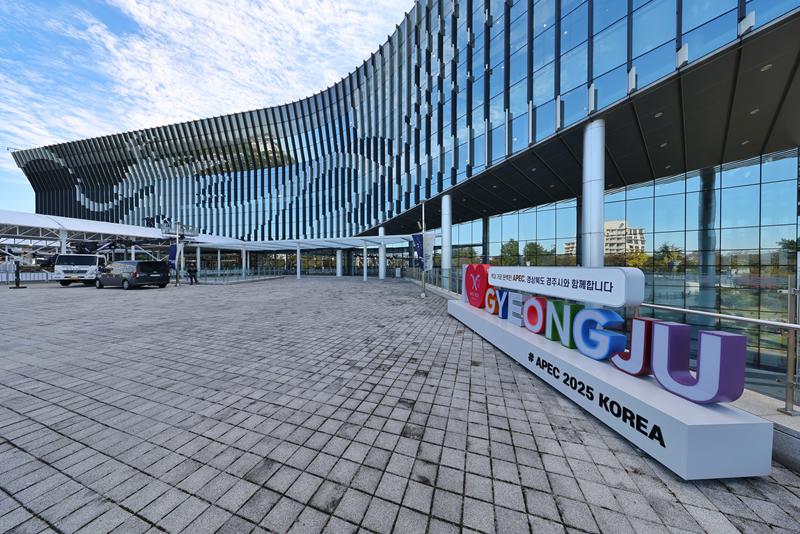




- BRNN
- BRI News
- BRNN News
- Database
Official Documents Polices and Regulations
Inter-government Documents International Cooperation BRI Countries
Business Guide Economic Data BRI Data
Trade
Investment Projects Latest projects
Cases - Content Pool

Photo shows the Gyeongju Hwabaek International Convention Center, the main venue for the upcoming 32nd Asia-Pacific Economic Cooperation (APEC) Leaders' Meeting in Gyeongju, South Korea. (Photo/Xiao Yi)
Chinese President Xi Jinping once said that openness is the lifeline of Asia-Pacific cooperation.
As the 32nd Asia-Pacific Economic Cooperation (APEC) Leaders' Meeting approaches, parties across the region are contemplating how to navigate uncertainty and plan for the future amid a turbulent international situation. China's vision in this regard has become more prominent.
Looking back, openness is the key to success in cooperation.
"It is precisely because the Asia-Pacific was freed from the shadow of the Cold War that this region, and particularly its small- and medium-sized economies, have been able to embark on a fast track toward modernization and create the Asia-Pacific miracle," Xi said.
APEC was born on the eve of the end of the Cold War, when a new round of economic globalization was gradually emerging. APEC has embodied the region's shared aspirations for peace and development, steadily evolving into a vital platform for open cooperation.
Between 1989 and 2022, total trade in goods and services within the APEC region surged from $3.1 trillion to $30 trillion. Today, the Asia-Pacific accounts for more than 60 percent of the global economy, nearly half of world trade and contributes 70 percent of global economic growth.
Over the past three decades, per capita income in the Asia-Pacific has more than quadrupled, and one billion people have been lifted out of poverty.
The Asia-Pacific, once a battleground for great power rivalry and a region fraught with international disputes, suffered greatly from conflicts and wars. A review of the past may offer clues as to what will happen in the future. History tells us that bloc confrontation cannot solve any problem and that bias will only result in disaster. It also tells us that closed-door development leads nowhere, while open development is the only right choice.

A flag flies outside the venue for the upcoming 32nd Asia-Pacific Economic Cooperation (APEC) Leaders' Meeting in Gyeongju, South Korea. (Photo/Xiao Yi)
Openness stands as both a consensus and a solution to regional challenges.
APEC members are gathering in Gyeongju, South Korea, at a time when rising unilateralism and protectionism are weighing heavily on regional development.
Humanity is at a crossroads. "No matter how the international landscape may evolve, we must stay committed to building an open global economy, so as to share opportunities and achieve win-win outcomes in openness," Xi said. This Chinese vision has become the mainstream consensus across the Asia-Pacific.
Throughout this year, regional leaders meeting with President Xi have consistently raised the topic of openness. New Zealand is willing to actively communicate and coordinate with China to safeguard the multilateral trading system. Singapore is willing to strengthen coordination and cooperation with China on regional and multilateral platforms to jointly uphold multilateralism and the international order. Australia is willing to work with China to uphold multilateralism, support the important role of the United Nations and jointly safeguard free trade and World Trade Organization rules.
In the first three quarters, China's trade with ASEAN totaled 5.57 trillion yuan ($785 billion), up 9.6 percent year on year.
Facts clearly demonstrate that mutual support and working together enable steady navigation and progress when the wind is strong and the tides are high.
The China-ASEAN Free Trade Area 3.0 Upgrade Protocol was signed on Tuesday, marking another milestone in regional open cooperation. As two major global economies, China and ASEAN's decision to upgrade open cooperation against headwinds not only enhances their respective capacity to manage development risks but also injects strong momentum into building an open world economy.
Meanwhile, openness represents the prevailing trend determining the region's future.
"Though countercurrents are sure to exist in a river, none could stop it from flowing to the sea. Driving forces bolster the river's momentum, and resistance may yet enhance its flow," Xi said.
Endogenous drivers for openness continue to emerge. Innovation holds the key to breaking through growth bottlenecks, while green development is the defining color of our times. China's green industries are flourishing, and through partnerships with Southeast Asia, Latin America and other regions, new industrial hubs are taking shape, supporting green transformation across participating economies while forging a new ecosystem for regional industrial and supply chain cooperation.
Governance consensus supporting openness has become clearer. The multilateral trading system is an indispensable international public good for the development of all parties. As a major player in the world economy, the Asia-Pacific needs to shoulder greater responsibility by taking the lead in upholding global trade rules.
The theme for the 32nd APEC Leaders' Meeting is "Building a Sustainable Tomorrow: Connect, Innovate and Prosper," conveying a broad consensus on safeguarding openness.
"The success of the Asia-Pacific is due to our firm commitment to peace and stability in the region, to our continuous practices of true multilateralism and open regionalism, and to our deep faith in the trend toward economic globalization as well as mutual benefit and mutual success," Xi said.
"We must remain steadfast in our commitment to APEC's founding mission. We must respond to the calls of our times responsibly and meet global challenges together. We must fully deliver on the Putrajaya Vision of building an open, dynamic, resilient and peaceful Asia-Pacific community for the prosperity of all our people and future generations," Xi added.

Tel:86-10-65363107, 86-10-65368220, 86-10-65363106